
Sierra Foothills is a vast American Viticultural Area (AVA) encompassing the foothill "belt" of the Sierra Nevada in north-central California, United States. It was established on December 18, 1987 by the Bureau of Alcohol, Tobacco and Firearms (ATF), Treasury after evaluating the petition filed by the Sierra Foothills Winery Association of Somerset, California for the establishment of a "Sierra Foothills" viticultural area in portions of Yuba, Nevada, Placer, El Dorado, Amador, Calaveras, Tuolumne and Mariposa Counties. Wine grapes were introduced to the area in the nineteenth century during the California Gold Rush. Over 280 vineyards/wineries are located within its boundaries.
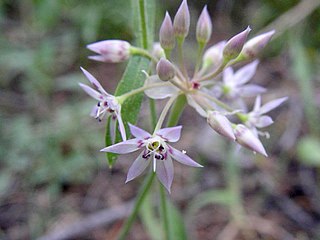
Allium campanulatum is a species of wild onion known by the common name dusky onion or Sierra onion. This is a flowering plant native to the western United States from southeastern Washington and northern Oregon to southern California, and western Nevada. The dusky onion grows in foothills and mountains, especially in dry areas, such as chaparral habitats.
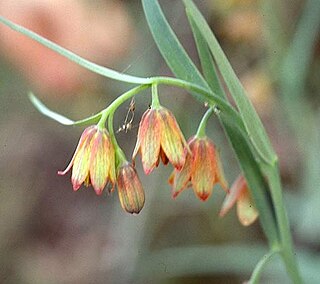
Fritillaria eastwoodiae, also known as Butte County fritillary or Eastwood's fritillary is a rare member of the Lily family (Liliaceae), native to the foothills of the northern Sierra Nevada, and Cascade Mountains in California and southern Oregon, USA.
Erythronium pluriflorum is a rare species of flowering plant in the lily family Liliaceae which is known by the common names manyflower fawn lily,golden fawn-lily, and Shuteye Peak fawn lily.

Epilobium oreganum is an uncommon species of flowering plant in the evening primrose family known by the common names Grants Pass willowherb and Oregon fireweed. It is native to southern Oregon and northern California, where it is historically known mostly from the Klamath Mountains. It is currently confirmed to exist only in Josephine County, Oregon, and Trinity County, California, where it grows in boggy areas on serpentine soils. It is a perennial herb growing up to a meter in height with thin, hairless stems. The red-veined leaves are oval to lance-shaped and up to 9 centimeters long. The inflorescence bears flowers with pink petals just over a centimeter long and a protruding pistil. The fruit is a hairy, glandular capsule up to 4.5 centimeters long.

Epilobium siskiyouense is a rare species of flowering plant in the evening primrose family known by the common names Siskiyou willowherb and Siskiyou fireweed.

Erigeron petrophilus is a species of flowering plant in the family Asteraceae known by the common names rockloving erigeron or cliff fleabane. It is native to the mountain ranges of California from Siskiyou County south as far as San Luis Obispo County and El Dorado County. It also grows in southwestern Oregon.
Hackelia amethystina is a species of flowering plant in the borage family known by the common name amethyst stickseed.

Lessingia leptoclada is a species of flowering plant in the family Asteraceae known by the common name sierra lessingia. It is endemic to the Sierra Nevada of California, where it is known from several types of local habitat. This is a slender annual herb growing erect and varying in size from just a few centimeters to nearly a meter tall, with long, spreading branches. It is very glandular and often hairy or woolly in texture. The upper leaves are up to 5 centimeters long, narrow and sometimes toothed or lobed; the lower leaves are longer and wither early. The flower heads appear singly or in small clusters. Each head is lined with woolly phyllaries. The head is discoid, containing no ray florets but many funnel-shaped pinkish, lavender, or light bluish-purple disc florets with large lobes. The fruit is an achene with a whitish pappus of bristles.
Leptosiphon oblanceolatus is a species of flowering plant in the phlox family known by the common name Sierra Nevada linanthus.
Monardella beneolens is a rare species of flowering plant in the mint family known by the common name sweet-smelling monardella.
Nemacladus interior is a species of flowering plant in the bellflower family known by the common name Sierra threadplant. It is native to the Sierra Nevada of California, and it is known from Oregon as well. It grows in mountain forest habitat. It is an annual herb producing a stiff upright purple-brown stem up to about 25 centimeters tall. Small toothed oval leaves 1 to 2 centimeters long occur at the base of the plant. The inflorescence is a zigzagging series of branches bearing occasional flowers on thin pedicels. There is a single tiny bract at the base of each pedicel. The flower is a few millimeters long. It has five triangular sepals and five corolla lobes, three lobes on the upper lip and two on the lower. The corolla is white to pale purple or pink with a thin red band and yellow spot at the base of each lobe.
Pseudobahia bahiifolia is a rare species of flowering plant in the family Asteraceae known by the common name Hartweg's golden sunburst.
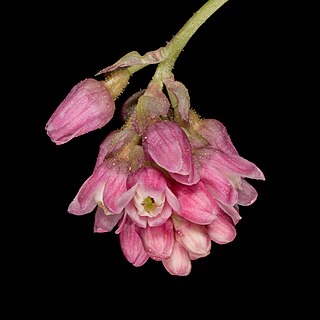
Ribes nevadense is a species of currant known by the common names Sierra currant and mountain pink currant.

Micranthes aprica is a species of flowering plant known by the common name Sierra saxifrage. It is native to the high mountains of California, including the Sierra Nevada and the southern Cascade Range, and adjacent slopes in southern Oregon and western Nevada. It grows in mountain habitat in areas of alpine climate, such as meadows and next to streams of snowmelt. It is a perennial herb which spends most of the year in a dormant state in order to save water, and rarely flowers. It produces a small gray-green basal rosette of toothed oval leaves up to about 4 centimeters long. When it does bloom, it sends up an erect inflorescence on a peduncle several centimeters tall topped with a cluster of flowers. Each flower has five sepals, five small white petals, and a clump of whiskery stamens at the center.
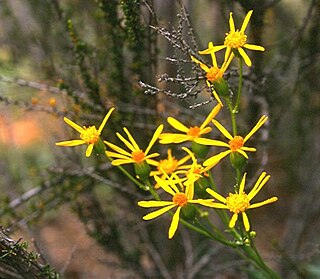
Packera layneae, known by the common name Layne's ragwort and Layne's butterweed, is a rare species of flowering plant in the aster family.
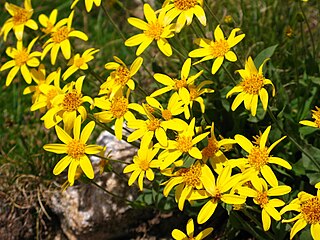
Packera werneriifolia, known by the common names alpine rock butterweed and hoary groundsel, is a species of flowering plant in the aster family. It is native to the western United States in the Sierra Nevada mountain habitat in subalpine and alpine climates, including forests and barren talus.
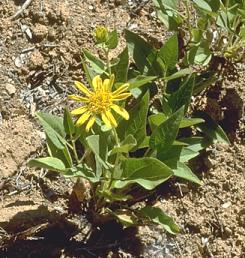
Agnorhiza reticulata, known by the common name El Dorado County mule's ears, is a rare species of flowering plant found only in a small region of north-central California.

Yuba Pass is a mountain pass on State Route 49 in Sierra County in the U.S. state of California. The pass lies at an elevation of 6,710 ft (2,050 m) about 3.4 air miles west of Sattley, on the divide between the North Yuba River and the Middle Fork Feather River. Thus, unlike most of the well-known Sierra Nevada passes, including the much lower Beckwourth Pass on the east edge of the Sierra Valley, Yuba Pass does not lie on the Great Basin Divide.

The flora of the U.S. Sierra Nevada alpine zone is characterized by small, low growing, cushion and mat forming plants that can survive the harsh conditions in the high-altitude alpine zone above the timber line. These flora often occur in alpine fell-fields. The Sierra Nevada alpine zone lacks a dominant plant species that characterizes it, so may or may not be called a vegetation type. But it is found above the subalpine forest, which is the highest in a succession of recognized vegetation types at increasing elevations.













